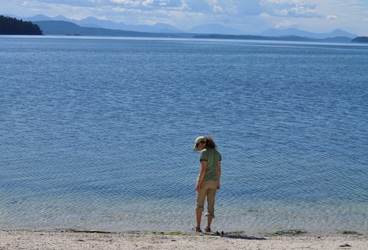
Del Viento- Windy, beach
Do you remember when not a single grocery store in America sold pomegranate juice? When you first heard of acai berries? When tofu was hard to find? Before hemp milk, goji berries, and tempeh?
Well, I’m glad you’re here. I’m about to announce The Next Big Thing.
Are you ready?
No—wait—first, some background.
Just nights before we left Victoria, our friends Jim and Tricia aboard Falcon VII gave us a briefing, pictures and stories and need-to-know info from their multiple trips north to Alaska. We hung on every word and studied every image.
Then they told us a secret.
They said we’d find it just at the high-tide line. They said to pick only the tender ends. They said we could eat it raw or sauté it. They said it is salty, delicious, and nutritious. They called it…sea asparagus.

We tucked the info in the back of our minds and then bid Victoria a warm farewell. Neither of us gave sea asparagus a second thought.
Then, a week later, anchored off Galiano Island, in a little cove near Montague Harbor, we sat quietly in the cockpit and listened to a clear, authoritative voice coming from a large group ashore. An interpreter was lecturing a bunch of city kids ferried over from a Vancouver school. Maybe we would learn something…
“And here, just above the high-tide line, is…does anyone know what this is called? No? It’s sea asparagus—everyone pick off a bit and try it.”
Ten minutes later, Windy, the girls, and I were ashore, poking around the area where the sea-asparagus-eating group had been.
“I think this is it,” Windy said, nibbling on a tender green shoot. “Funny, I always thought this plant was called pickleweed.”
We harvested a bunch and rowed back to Del Viento to make dinner—a sea asparagus-inspired Asian stir-fry over brown rice. It was very good.
And then I learned more about this stuff. It is amazing. It doesn’t need fresh water to grow, it’s high in protein, rich in polyunsaturates, and it’s hyper-photosynthetic (meaning it sucks carbon dioxide out of the air really fast compared to other plants).
And that’s not all. A company in Mexico is apparently farming this stuff on the banks of the Sea of Cortez, in Bahia Kino (where they filmed most of Catch-22, by the way) to turn it into biodiesel. In England, they call it samphire and they’re already eating it with butter or olive oil. In other parts of the world, they call it umari keerai and grow it for livestock feed. The Sri Lankans feed it to donkeys.
And Windy was right, pickleweed is a San Francisco name for this stuff. Botanists call it Salicornia.
Mark my words: It’s only a matter of time before some clever entrepreneur partners with an M.D. to claim sea asparagus contains the specific micronutrients you need to boost your memory, strengthen your immune system, and prevent cancer. Next thing you know, sea asparagus (or maybe the marketing folks will opt for umari keerai) will make the list of Ten Superfoods You Should Be Eating Every Day. Then, the next time you’re in the produce section of your local grocery store, it will be right there, packaged in neat little bundles and wrapped in cellophane, next to the collection of fancy mushrooms, like it’s been there forever, and priced exorbitantly.
But for now, we’ll keep munching away for free—it is supposed to be even more prolific in Southeast Alaska, where our bow is pointed.
Bon appetite!
--MR
Eleanor harvesting sea asparagus on a Strait of Georgia shore.
I__n our twenties, we traded our boat for a house and our freedom for careers. In our thirties, we slumbered through the American dream. In our forties, we woke and traded our house for a boat and our careers for freedom. And here we are. Follow along at http://www.logofdelviento.blogspot.com/








